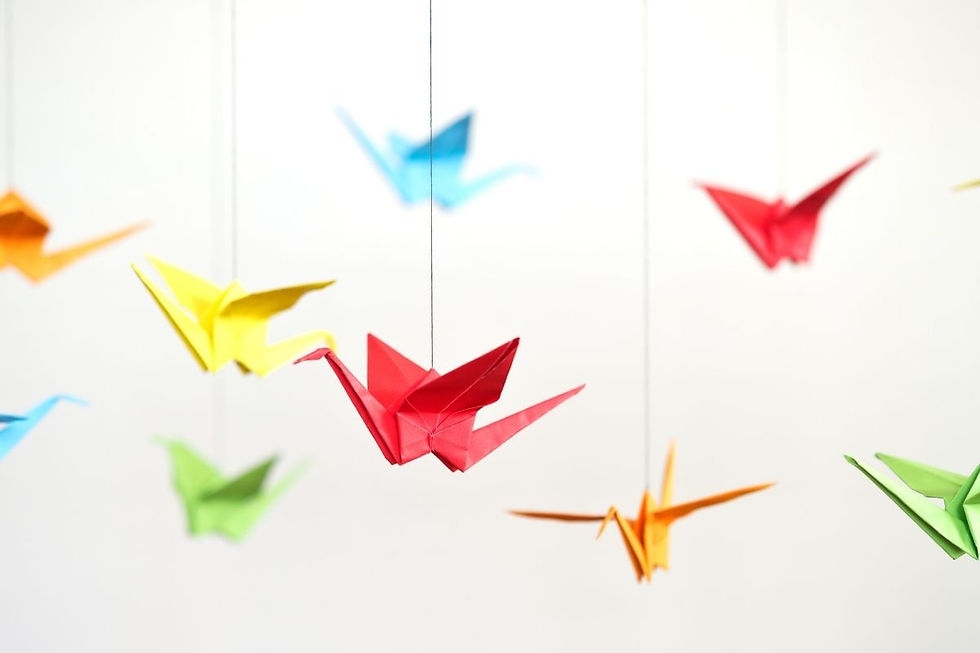Is it a bird? Is it a plane? No – it’s Origami!
According to Wikipedia, "Origami is the art of paper folding, which is often associated with Japanese culture. In modern usage, the word "origami" is used as an inclusive term for all folding practices, regardless of their culture of origin."
To those who don’t know much about origami, it might just look like intricate, beautiful, complicated art, but the truth behind it is that it is all about mathematics.
How can paper art be connected to mathematics you might wonder? Well, at the heart of it, Maths is about making sense of the rules and patterns of the universe. We look for patterns everywhere. Have you ever looked at the patterns of a leaf or a snowflake? Origami looks at the geometry of the 'crease pattern' in the paper.
There are valley creases and mountain creases. A mountain crease is a fold where the two ends of paper go down and the fold is pointed upwards. It looks like a mountain. A valley crease is the opposite. The fold is at the bottom, and the ends of paper are facing upwards, to look like a valley. A vertex (corner), is where the mountain and valley creases meet. When working with a piece of paper to make origami, we look where the lines intersect, what angles they form, and if they are mountain or valley creases.
If you are ever lucky enough to hold an intricate piece of origami artwork, you might be tempted to unfold it and see how it was made. If you did, you would see the pattern of creases that act as a blueprint for the piece. The crease pattern is the key to understanding the secret behind how the paper is able to fold into a beautiful model. The door the key unlocks is to a world of fascinating mathematics!

Origame.me explains the science behind pattern theory. When we look at mountain and valley creases, we can turn them into simple equations. If we subtract mountain folds from valley folds (or vice versa), the absolute difference is two. (We don’t include negative numbers.) For example: 5 mountain creases and 3 valley creases would be correct, since 5-3=2. BUT, 6 mountain creases and 2 valley creases wouldn’t work because 6-2=4. This rule is crucial when learning how to read and fold crease patterns, as it can save the artist a lot of time trying to fold 6 mountain creases and 5 valley creases since that’s not possible.
This is just one rule in the secret art of paper folding. There are others and they are all based on mathematics. More laws of origami are that no matter how many times you try to stack folds and sheets, a sheet can never penetrate a fold and that every other angle around the vertices comes out to 180 degrees.
While origami is beautiful to look at, art is not the only contribution it makes to our society. Origami has allowed us to view Science and Maths in a different way – a beautiful way. It has also provided us with some life-saving medical and technological breakthroughs like heart stents, satellite research and safety airbags.
As scientists, mathematicians and origami artists discover more and more of the mathematical rules that govern how paper folding works, origami gets more and more popular in many fields.
According to The Conversation, A group at the Conte National Centre for Polymer Research, led by Ryan Hayward have developed a way to make microscopic gel sheets swell along crease lines when heated. "These tiny self-folding gel objects might someday be used in bio-engineering. Imagine a toxic anticancer drug being enclosed in a self-folding origami ball, where the ball is programmed to unfold only when it comes in contact with a tumor. Then the drug can be delivered exactly to the tumor without poisoning other parts of the patient’s body."
Without understanding the mathematical rules behind origami, none of the amazing medical and technological advances could have been made. Origami is a wonderful example of how mathematics and beauty can be found in unexpected places.
"There’s always beauty, if you know where to look." – Patrick Ness.
At Me Education, we teach Cambridge IGCSE Mathematics which is accepted at leading universities and it opens the door to careers around the world. It’s not about studying for the sake of it. The Cambridge system prepares students for life. Learning about these important concepts arms them with the knowledge they need to understand the world around them and helps them develop an informed curiosity and a lasting passion for learning.
To learn more about our Mathematics offerings, please contact us at 2383 0300.
**
"I am a Form 3 student. Since joining ME Education, my English and Math skills have greatly improved. The lessons were fun and easy to understand. The teachers at ME are highly qualified and professional, while some of them are experienced examiners of public exams. I enjoy the learning atmosphere at ME very much. It is relaxing and comfortable. I am successfully enrolled at Harrow international school under the guidance of ME and I really appreciate the efforts of ME staff and teachers."
Angela


Comentários